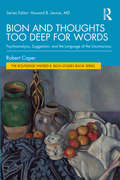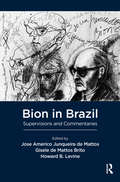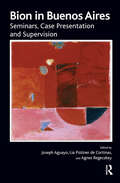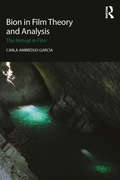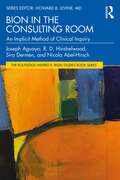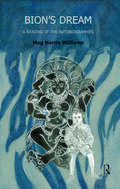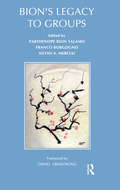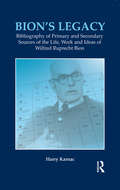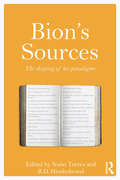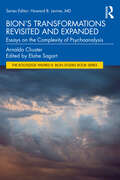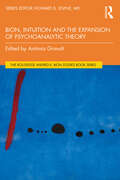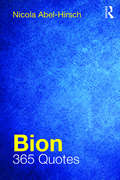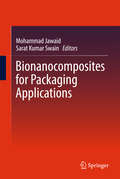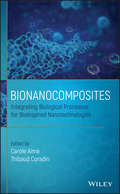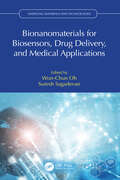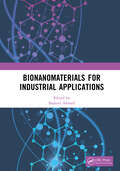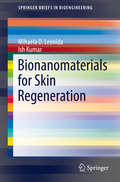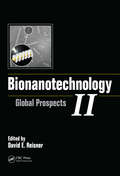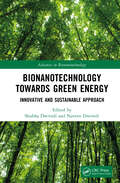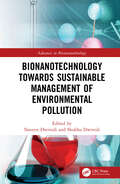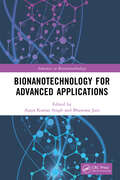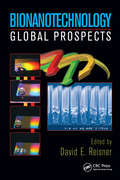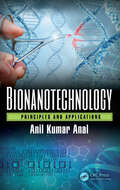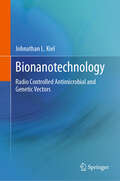- Table View
- List View
Bion and Thoughts Too Deep for Words: Psychoanalysis, Suggestion, and the Language of the Unconscious (The Routledge Wilfred R. Bion Studies Book Series)
by Robert CaperDistinguishing psychoanalysis, as a search for truth, from suggestion, as a cure for symptoms, this book addresses the scientific status of psychoanalysis. Citing research into the relationship of infants to their caretakers, the author discusses evidence that unconscious communication is present from birth, and that this form of communication plays a central role in psychoanalysis at a level below that of verbal communication.Informed by Bion's ideas of containment, group functioning and the fundamental psychological need for truth, this book asserts that psychoanalysis, based solely on the search for truth, has, among all psychological interventions, both a unique claim to scientific status and a unique ability to foster psychological development. Exploring the relationship between unconscious communication, group dynamics, containment and psychological development in a highly original way, Bion and Thoughts Too Deep for Words: Psychoanalysis, Suggestion, and the Language of the Unconscious will be of great interest to psychotherapists, psychologists and psychoanalysts who are interested in the relationship between psychoanalysis and suggestion.
Bion in Brazil: Supervisions and Commentaries
by Wilfred R. BionThe discovery, translation into English, and publication of these previously unpublished recordings of Bion's clinical supervisions in Sao Paulo, Brazil, with commentaries by leading Brazilian psychoanalysts, gives readers the opportunity to experience for themselves his clinical and theoretical thought as it emerges and evolves through a series of fascinating case discussions.
Bion in Buenos Aires: Seminars, Case Presentation and Supervision
by Wilfred R. BionThese newly discovered clinical seminars of Wilfred Bion, which include supervisions, personal case presentations, and lectures on psychoanalytic theory, represent his initial foray into many years of work that have inspired South American analysts for nearly a half a century.The clinical and theoretical work of Bion arguably ranks rather high in the current psychoanalytic firmament-as national and international conferences convene regularly to continue discussing the contemporary relevance of his work. His work has served as a source of inspiration to contemporary psychoanalysts in all three regions of the International Psychoanalytical Assocation-Ronald Britton, Antonino Ferro, Giuseppe Civitarese, Thomas Ogden, James Grotstein, and Paolo Sandler, just to name a few. These newly discovered clinical seminars from work Bion conducted in Buenos Aires in 1968 help us to further fill out the picture of his versatile gifts. In these seminars, we find lectures on Bion's elaborations on his epistemological research-still on-going in the 1960s when he went to Buenos Aires; a lecture on the Grid and its clinical relevance.
Bion in Film Theory and Analysis: The Retreat in Film
by Carla Ambrósio GarciaIn Bion in Film Theory and Analysis: The Retreat in Film, Carla Ambrósio Garcia introduces the rich potential of the thinking of British psychoanalyst Wilfred Bion for film theory. By so doing, she rethinks the space of the cinema as a space of retreat, and brings new insights into the representation of retreat in film. Presented in two parts, the book seeks to deepen our understanding of the film experience and psychical growth. Part I places Bion’s view on the importance of the epistemophilic instinct at the heart of a critique of the pleasure-centred theories of the cinematic apparatus of Jean-Louis Baudry, Christian Metz and Gaylyn Studlar, proposing an idea of cinema as ‘thoughts in search of a thinker’. Garcia then moves from Bion’s epistemological period to his later work, which draws on mysticism, in order to posit an emotional experience in the cinema through which the subject can be or become real (or at one with ‘O’). Part II examines representations of retreat in four European films, directed by Ingmar Bergman, Pier Paolo Pasolini, Georges Perec and Bernard Queysanne, and Manoel de Oliveira, showing them to articulate a gesture of retreat as an emotionally turbulent transitional stage in the development of the psyche – what Bion conceptualizes as caesura. Through its investigation of the retreat in cinema, the book challenges common understandings of retreat as a regressive movement by presenting it as a gesture and space that can also be future-oriented. Bion in Film Theory and Analysis will be of significant interest to academics and students of psychoanalysis, psychotherapy, and film and media studies, as well as psychoanalysts and psychotherapists.
Bion in the Consulting Room: An Implicit Method of Clinical Inquiry (The Routledge Wilfred R. Bion Studies Book Series)
by Nicola Abel-Hirsch Joseph Aguayo Sira Dermen R. HinshelwoodBion in the Consulting Room addresses the long-unanswered question of Bion’s clinical and supervisorial technique and examines the way Bion’s conceptual model and clinical practices informed his theoretical work.As Bion wrote about technique so rarely, the authors set about looking at many of his clinical and supervisorial examples to infer what might be learned from them. This book factors in the four distinctive periods of Bion's clinical and supervisorial work in chronological order: the group period of the 1940s; the period of the psychosis papers in the 1950s; the epistemological period of the early 1960s; and, finally, the period of his international group seminars in the late 1960s and 1970s. In all four periods, the authors examine and analyze his method of clinical inquiry, or how he went about knowing and experiencing his analysands and supervisees. The authors offer a uniquely overarching view of his method of clinical inquiry, uncovering an amazing consistency in how Bion went about his work both as a psychoanalyst and supervisor.This illuminating book is essential reading for psychoanalysts, psychotherapists, and psychologists interested in the work of Wilfred Bion and the importance of his legacy in contemporary practice.
Bion's Dream: A Reading of the Autobiographies
by Meg Harris Williams'This book offers a definitive reading of Bion's remarkable autobiographical writings from a perspective embedded in the poetry of the ages, that of the Romantics in particular. It is at once learned and, utterly freshly, able to explore the inside story of Bion's life and mind. The volume is a distillation and elaboration of the work of many years. Whilst ostensibly an extended commentary on the autobiographical works themselves, it is also, in its own right, a tour de force, engaging, as it does, with the heart of the matter: with the development of a psychoanalyst, of a life, a self, a mind, thoroughly inward with the "dark and sombre world of thought".'- Margot Waddell, psychoanalyst and consultant child psychotherapist, Tavistock Clinic
Bion's Legacy to Groups
by David Armstrong Franco Borgogno Parthenope Bion Talamo Silvio A. Merciai'It is characteristic of some forms of scientific genius to alter not just what we see in the world, but how we see it - not just the view, but the lens. One thinks of Freud's discovery of the transference, or of Melanie Klein's attention to the play of children. Wilfred Bion's study of groups and group processes also has this quality. More than the content of what he saw and captured in the concepts of two modes of mental functioning in groups and in the differentiation of the basic assumptions, it was the way he saw or, more broadly, the way he sensed the emotional life of the individual in the group, and in the first instance his own, that opened up a quite new territory for exploration. Those of us whose practice takes place primarily in the institutional or social domain can find in his more psychoanalytic work seeds of new thought extending beyond the consulting room.Going "beyond the confines" might perhaps more generally stand as a metaphor for Bion's enterprise.
Bion's Legacy: Bibliography of Primary and Secondary Sources of the Life, Work and Ideas of Wilfred Ruprecht Bion
by Harry KarnacThis book forms a comprehensive bibliography of the works of W. R. Bion, and the other works that made some bearing of his life and thought. It discusses Bion's contribution to various disciplines beyond the psychoanalytic and psychotherapeutic.
Bion's Sources: The shaping of his paradigms
by R. D. Hinshelwood Nuno TorresThere are an increasing number of publications concerned with the work of Wilfred Bion (1897-1979). Many have sought new ideas from his writing however, little attention has been paid to the intellectual context in which Bion wrote. Bion’s Sources traces where Bion’s new ideas came from, what job he required of them, how successfully he used his context and how that has fertilised psychoanalysis. Expert contributors provide chapters on areas of the intellectual context separate from or adjacent to clinical psychoanalysis in Britain which have clearly influenced the texts Bion left (those published in his life time, or subsequently). Chapters explore the influences deriving from Wilfred Trotter, Henri Bergson and process philosophy, Kurt Lewin and group dynamics, Immanuel Kant, R. B. Braithwaite and the philosophy of science, the mathematics of notation and transformation, as well as the work of psychoanalysts who have applied their theories to social science, psychosomatics, and literature and the humanities. By contextualising Bion in the wider culture of ideas, and removing him from the exclusive world of Psychoanalysis, Bion’s Sources aims to moderate his ‘genius’ by showing how it was shaped by very wide influences. This book will be of interest to psychoanalysts, clinicians and those interested in the history of psychoanalytic ideas.
Bion's Transformations Revisited and Expanded: Essays on the Complexity of Psychoanalysis (The Routledge Wilfred R. Bion Studies Book Series)
by Arnaldo ChusterIn this illuminating volume, Arnaldo Chuster provides a thorough critique of Wilfred Bion's seminal 1965 work, Transformations. Offering a rich and nuanced opportunity to enhance one's understanding of this pivotal psychoanalytic text, Chuster establishes a link between the practice of psychoanalysis and Bion's advanced theory, including the key challenges he encountered in the clinical setting with patients. Working through Transformations, Chuster embarks on a courageous journey to follow Bion's path in creating a dialogue between multiple disciplines, explicating and expanding upon the core concepts of different types of transformation. Chuster recognizes Transformations as a pivotal point in Bion's publications, highlighting the profound manifestations of complex thinking it exhibits. Following the complexities of Bion's ideas, the book offers invaluable insights and expansions on topics such as ethics, aesthetics, and their application in imaginative conjectures, while also providing a rigorous discussion on the scientific foundations of Bion's work. Chuster's innovative perspectives and dedication to the work of Bion make this book a must-read for all psychoanalysts interested in demystifying the often convoluted work of this most eminent analyst and bringing his insightful theories into the 21st century.
Bion, Intuition and the Expansion of Psychoanalytic Theory (The Routledge Wilfred R. Bion Studies Book Series)
by Antònia GrimaltBion, Intuition and the Expansion of Psychoanalytic Theory illuminates how Bion’s work on intuition has changed the landscape of contemporary psychoanalysis through his understanding of its supra-scientific and non-sub-scientific condition. Based on the work of the biannual Bion conference, this book includes contributions from the most eminent voices on Bion’s work. The global cohort of contributors in this volume examine topics such as dream work, the Infinite Unconscious, the Spectral model of the mind, the realm of the minus and observation and intuition. Each chapter explores different elements arising from Bion’s insistence on learning from experience and establishing the difference between knowing and becoming as an experiential process of the mind as a container in relation to its contents of sensations, feelings, dreams and thoughts. This book will be of key interest to analysts and analytic therapists of all schools and is an essential resource for those that follow the work of Bion.
Bion: 365 Quotes
by Nicola Abel-HirschThis is a book of 365 quotes from the work of the psychoanalyst Wilfred Bion. Something of an enigma, Bion often doesn't write in the way one would expect of a psychoanalyst, but is being read ever-increasingly around the world, in and outside the psychoanalytic community. Certain of his comments are often quoted, whilst swathes of his work lie almost untouched. How to make some of the detail of this work available? What he writes is often dense in the way the structure of a poem can be, and the book has the format of a 'poem a day' collection – providing a way into his complete work one quote at a time. Alongside commentaries by Abel-Hirsch are thoughts on Bion's work drawn from papers by other analysts from the UK, the Americas, and Europe. The book is structured in a way that will inform and interest the general reader as well as giving something new to psychoanalysts and others who already know his work well.
Bionanocomposites for Packaging Applications
by Mohammad Jawaid Sarat Kumar SwainThis book presents a unified overview of eco-friendly bionanocomposites on the basis of characterization, design, manufacture, and application. It also explores replacing conventional materials with bionanocomposites with a focus on their use in packaging applications. In addition, the book broadens readers' insights by providing illustrations and tables summarizing the latest research on the packaging applications of different bionanocomposites. By offering a detailed account of this field of research and describing real-world applications, it enables researchers, scientists, and professionals in industry to develop a more informed understanding of the need for bionanocomposites in the development of green, biodegradable, and sustainable packaging applications.
Bionanocomposites: Integrating Biological Processes for Bioinspired Nanotechnologies
by Thibaud Coradin Carole AiméBeginning with a general overview of nanocomposites, Bionanocomposites: Integrating Biological Processes for Bio-inspired Nanotechnologies details the systems available in nature (nucleic acids, proteins, carbohydrates, lipids) that can be integrated within suitable inorganic matrices for specific applications. Describing the relationship between architecture, hierarchy and function, this book aims at pointing out how bio-systems can be key components of nanocomposites. The text then reviews the design principles, structures, functions and applications of bionanocomposites. It also includes a section presenting related technical methods to help readers identify and understand the most widely used analytical tools such as mass spectrometry, calorimetry, and impedance spectroscopy, among others.
Bionanomaterials for Biosensors, Drug Delivery, and Medical Applications (Emerging Materials and Technologies)
by Suresh Sagadevan Won-Chun OhThis book covers advances in nanostructured materials across a variety of biomedical applications as the field evolves from development of prototype devices to real-world implementation. It provides an in-depth look at the current state of the art in oxide nanostructures, carbon nanostructures, and 2D material fabrication and highlights the most important biomedical applications and devices of nanomaterials, including drug delivery, medical imaging, gene therapy, biosensors, and diagnostics. FEATURES Presents the findings of cutting-edge research activities in the field of nanomaterials, with a particular emphasis on biological and pharmaceutical applications Details finished and ongoing toxicity evaluations of emerging nanomaterials Offers a multidisciplinary perspective This book is recommended for senior undergraduate and graduate students, professionals, and researchers working in the fields of bioengineering, materials science and engineering, and biotechnology.
Bionanomaterials for Industrial Applications
by Shakeel AhmedBionanomaterials for Industrial Applications is a comprehensive guide to the current state of bionanomaterials research and their prospective applications in a variety of industrial sectors. The book discusses the properties of bionanomaterials, types and their potential applications in various disciplines, such as biomedicine, food industry, environment, etc. It provides a comprehensive overview of the current state of bionanomaterials research and their potential applications, making it an indispensable resource for anyone interested in learning more about this dynamic and rapidly developing field.Features: Discusses properties, classifications, and synthesis of bionanomaterials in addition to industrial applications Covers circular economy and life cycle assessment of bionanomaterials Explores impact of bionanomaterials on environment and human health Includes individual chapters specifically focusing on a particular application of bionanomaterials Reviews detailed industrial applications in particular field viz. environmental, food sciences, biomedical, and so forth This book is designed for researchers, scientists, engineers, and graduate students working in the field of bionanomaterials, as well as industrial professionals who could benefit from the use of bionanomaterials.
Bionanomaterials for Skin Regeneration (SpringerBriefs in Bioengineering)
by Mihaela D. D. Leonida Ish KumarThis book gives a concise overview of bionanomaterials with applications for skin regeneration. The advantages and challenges of nanoscale materials are covered in detail, giving a basic view of the skin structure and conditions that require transdermal or topical applications. Medical applications, such as wound healing, care for burns, skin disease, and cosmetic care, such as aging of the skin and photodamage, and how they benefit from bionanomaterials, are described in detail. A final chapter is devoted to the ethical and social issues related to the use of bionanomaterials for skin regeneration. This is an ideal book for researchers in materials science, medical scientists specialized in dermatology, and cosmetic chemists working in formulations. It can also serve as a reference for nanotechnologists, dermatologists, microbiologists, engineers, and polymer chemists, as well as students studying in these fields.
Bionanotechnology II: Global Prospects
by David E. ReisnerThe impact and importance of nanotechnology continues to grow, and nanomedicine and biotechnology have become areas of increased development. Biomedical engineers who work with biological processes and structures must have a deeply rooted understanding of the role of bionanotechnology, a rapidly evolving sector of the nanotechnology field. Bionanot
Bionanotechnology Towards Green Energy: Innovative and Sustainable Approach (Advances in Bionanotechnology)
by Shubha Dwivedi and Naveen DwivediBionanotechnology Towards Green Energy explains the role of bionanotechnology in the next generation technologies of green energy from an interdisciplinary and sustainability perspective. Chapters cover different roles of bionanotechnology such as applications of bio-nano enabled materials/coatings, scaling-up of green energy production, design and synthesis of bio-inspired nanomaterials and their applications, bio-nanofluid-based photovoltaic thermal systems, the use of bio-templated and biomimetic materials, and so forth. It focuses on waste-to-energy conversion and fixing intricate environmental issues. Key features: Provides detailed coverage of green energy production through bionanotechnological intervention Reviews future research needs in bionanotechnology in the green energy sector and scientific challenges in the mitigation of energy crises Deals with cutting-edge research on microbial synergism in biohydrogen production and storage Discusses the fabrication of bio-nano/hybrid electrode materials for supercapacitors and energy storage devices Includes extensive illustrations, case studies, summary tables, and up-to-date references This book is aimed at researchers and professionals in bionanotechnology, energy sciences, and environmental engineering.
Bionanotechnology Towards Sustainable Management of Environmental Pollution (Advances in Bionanotechnology)
by Naveen Dwivedi Shubha DwivediThis book highlights the characteristics, aims, and applications of bionanotechnology as a possible solution for sustainable management and bioremediation of environmental pollutants. It covers remediation of toxic pollutants, removal of emerging contaminants from industrial wastewater, eco-design and modification study of bio-nanoparticles and life-cycle assessment, nano-filtration, bio-nanomaterials based sensors for monitoring air and water pollution, resource recovery from wastewater, and highlights Internet of things-based green nanotechnology.Provides a comprehensive solution of environmental problems in sustainable and cost-effective modeReviews bionanotechnological applications in nanomaterials design, modification, and treatment of emerging contaminants from industrial wastewater.Covers Eco-design study of bio-nanomaterials, bio-nano filters, and assessment for the treatment of emerging pollutantsIncludes IoT- based bionanotechnologyExplores future research needs on bionanotechnology and scientific challenges in the mitigation of environmental pollutantsThis book is aimed at researchers, professionals, and graduate students in nanobiotechnology, environmental engineering, biotechnology.
Bionanotechnology for Advanced Applications (Advances in Bionanotechnology)
by Ajaya Kumar Singh Bhawana JainThis book provides the fundamental aspects of bionanomaterials and bionanotechnology, and insight into the synthesis and modification of bionanomaterials in a detailed manner. It initiates with a general overview of biotechnology and nanotechnology followed by different strategies and methodologies for the synthesis of nanomaterials. Further, it discusses pertinent topics such as protein engineering, analysis, mechanisms of microbe- mediated nanosynthesis, followed by various challenges and innovation strategies, and the role of enzymes in bionanotechnology.Features: Covers the synthesis of bionanomaterials, including the interaction between nanomaterial and biogenic materials Encompasses the study of the connections between structure, molecular biology, and nanotechnology Explains several techniques (XRD, SEM, TEM, etc.) used for the analysis of bionanomaterials Includes prospects, challenges, and opportunities associated with bionanotechnology Reviews the interaction between nanomaterials and the biological system and self- assembly in bionanotechnology This book is aimed at graduate students and researchers in materials sciences, biotechnology, and bionanotechnology.
Bionanotechnology: Global Prospects
by David E. ReisnerAs the impact and importance of nanotechnology continues to grow, nanomedicine and biotechnology have become areas of increased development. Drug delivery by nanoparticulates and nanocoatings for medicial devices are among the many new techniques on the horizon. Years from now we will laugh at the approaches to treating disease we currently conside
Bionanotechnology: Principles and Applications
by Anil Kumar AnalThis book deals with a subject of high interest and importance in all sectors, including biomedical, food, agriculture, energy, and environment. Biological systems are essential in nanotechnology, and many new applications are being developed by mimicking the natural systems. Approaching these topics from an engineering perspective, the book offers insight on the details of nanoscale fabrication processes as well as cell biology. The basics of biology and chemistry, with a focus on how to engineer the behavior of molecules at the nanoscale, are also explored and analyzed. The aim of the text is to provide the reader with broader knowledge of biological methods for signal transduction and molecular recognitions systems and how they can be replicated in bio-sensing applications. The reader will learn the basic structures and interactions of biomacromolecules for developing biocompatible and eco-friendly devices.
Bionanotechnology: Radio Controlled Antimicrobial and Genetic Vectors
by Johnathan L. KielThis book describes how methodologies in biochemistry, molecular and cellular biology, electromagnetic bioeffects, and nanotechnology were brought together to construct a nanostructure that is a composite of nucleic acid, carbon nanotube, paramagnetic metallic nanoparticles, and aromatic polymer that is responsive to nonionizing electromagnetic radiation, RFR to microwaves. It demonstrates that the construct can act as a redox catalyst accelerated by nonionizing electromagnetic radiation, and also as a conveyor of genetic modification of specifically targeted eukaryotic and prokaryotic cells. The scientific knowledge necessary to accomplish this is described and step-by-step progress supported by data and examples are noted. The general purpose is to show how such interdisciplinary approaches can lead to disruptive technologies. This book is most valuable to those (molecular biologists, vaccinologists, biomedical engineers, microbiologists) looking for more externally controllable gene vectors, antimicrobials, and antiparasitics, using a totally new nanoparticle platform. Those pursuing biological applications of nanotechnology will also be interested. This text has uniquely multidisciplinary approaches, drawing together chemistry, physics, molecular biology, biochemistry, and biomedical and electrical engineering.
Bionic Bling
by Rachel CraftArtificial replacement joints have to be tough and extra smooth. That’s why doctors use replacement joints made with the same long-lasting and strong stuff as sapphires and rubies, a natural mineral called alumina. Learn more about why this gemstone is perfect for making new joints!
